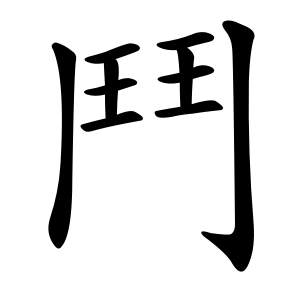鬥
- to fight, to struggle;
Etymology
The character is composed of two facing 丮 (meaning "to grasp"), symbolizing two people fighting barehanded. The two vertical strokes on each side represent the bodies of the two people, and the 玨 (double jade) in the center symbolizes the hands of the fighters.
• Major variant forms of 鬥 include 鬭 and 鬪.
• In Greater China, 鬥 is the standard form.
• In Korea and Japan, 鬪 is the standard form.
• In Japanese shinjitai (simplified characters), 鬪 has been modified to 闘, where the top part is changed to 門. In simplified Chinese, 鬥 is further simplified to 斗.
In fact, there are over 30 variant forms of this character, including those from shinjitai and simplified Chinese. Characters that include elements like 門, 斗, 豆, 㪷, 剅, 有, or 鼓 within their structure all share the root meaning of "fight" from 鬥.
Usage in Korean
When used as a radical, it conveys the meaning of conflict or struggle.
Examples of characters using this radical:
鬭 (original form of "fight")
鬪 (common form used in Korea and Japan)
鬧 (Nyo – to quarrel or make noise)
鬩 (Hyeok – to dispute)
鬨 (Hong – to fight)
Alternative forms
Since this radical is relatively uncommon, 鬥 is often replaced with 門 in writing. Thus, every character under the 鬥 radical also has a variant form that uses 門 instead. In simplified Chinese, characters under the 鬥 radical have been completely standardized to use 门 instead.
One exception is 鬨, which technically has a corresponding simplified form (⿵门共), but this variant was not officially adopted as a simplified character.
Characters with 鬥
- 中弓 (LN)
- ⿲ 𩰋 王 亅
